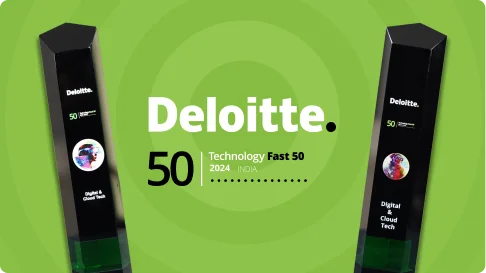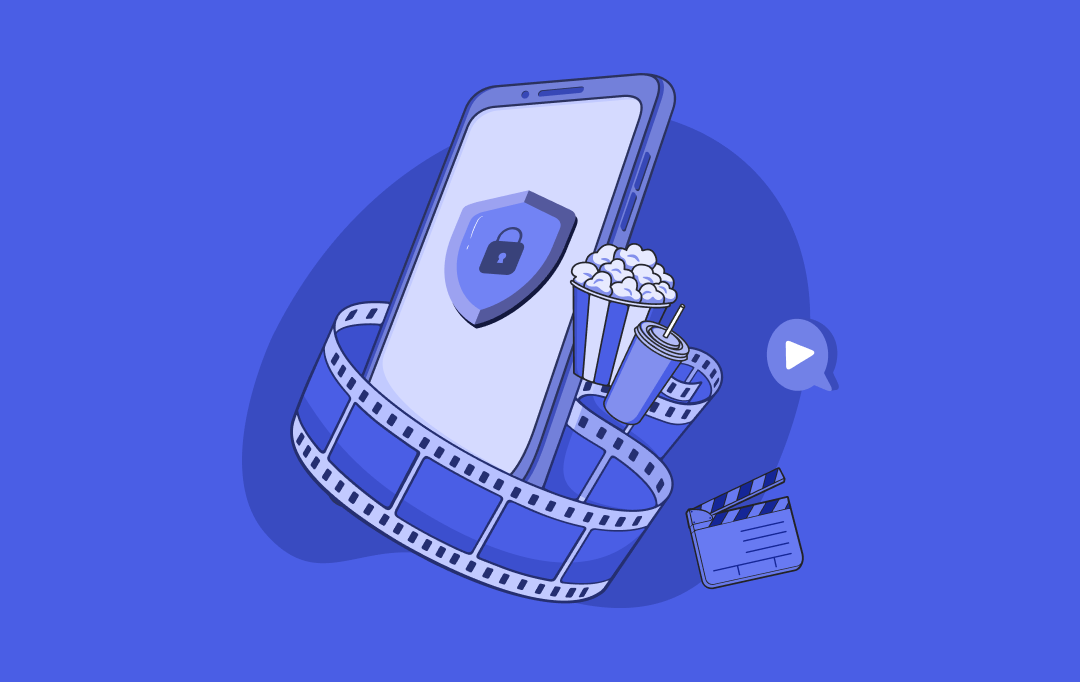- What OTT Platforms Can Learn From Cybersecurity Breaches?
- 10 OTT App Security Risks and Their Solutions
- Insecure APIs
- Poor Session Management
- Content Piracy and Stream Hijacking
- Credential Stuffing and Account Takeovers
- Insecure Third-Party Integrations
- Unencrypted Data Transmission
- Lack of Code Obfuscation and Reverse Engineering Protection
- Insufficient Logging and Monitoring
- Weak User Authentication and Authorization
- Inadequate Data Storage and Disposal Practices
- How Appinventiv Helps You Build Secure OTT Platforms from Day One
- FAQs.
As the demand for on-demand content continues to surge, OTT platforms handle more than just high traffic; they manage vast amounts of user data, digital assets, and third-party integrations with significant security implications. What was once considered a niche service is now a critical infrastructure layer in the global media and entertainment landscape, making it a prime target for cyber threats.
- 35% of consumers have used someone else’s streaming video-on-demand (SVOD) password.
- 42% of consumers watched pirated content in the past year.
- Among these, 15% reported using borrowed passwords.
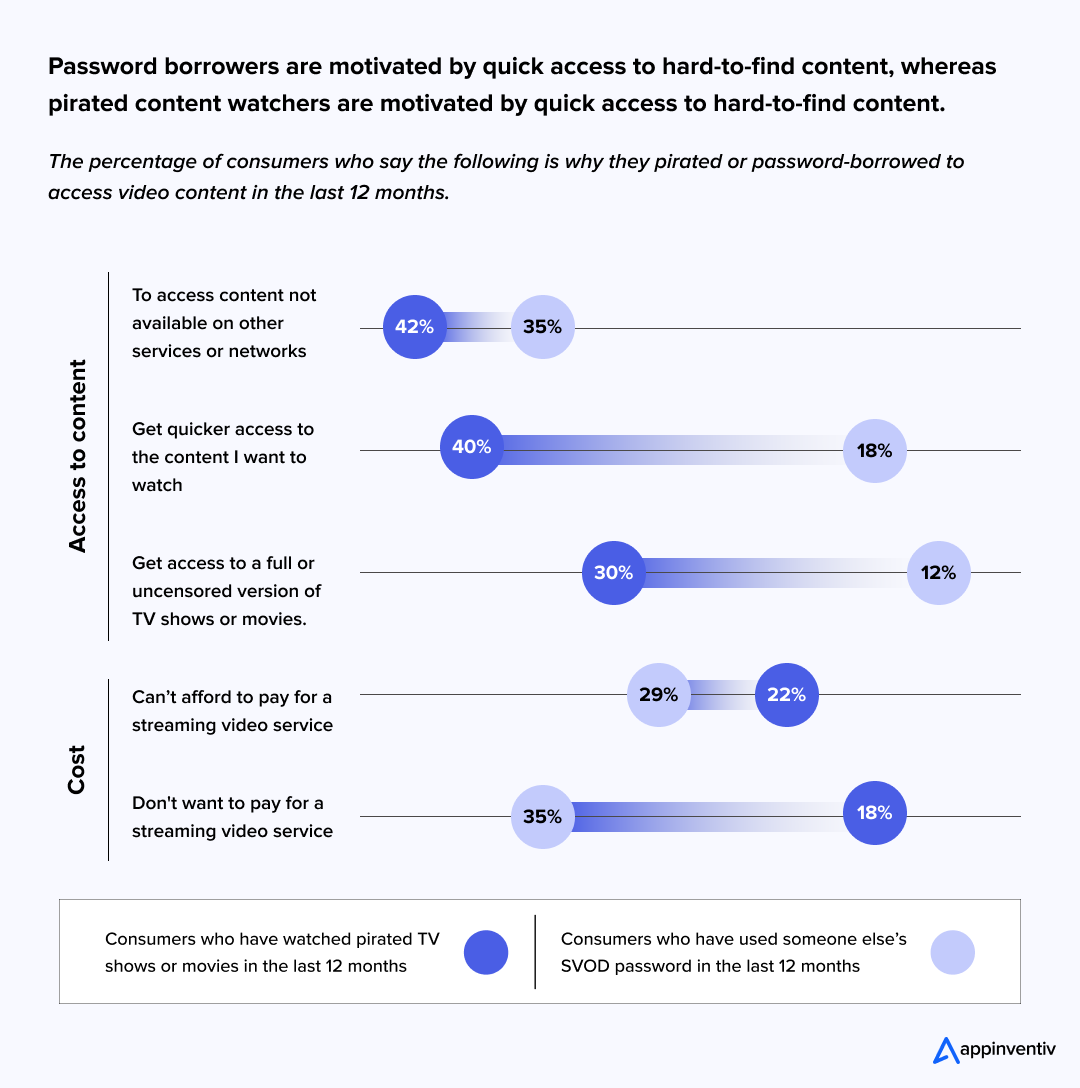
However, account sharing and unauthorised logins are the major challenges to OTT App security.
From exposed APIs and inadequate access controls to unsecured content delivery mechanisms, attackers are finding increasingly sophisticated ways to infiltrate over-the-top apps security environments. While many platforms invest heavily in performance and user experience, security often remains an afterthought – until it’s too late.
A single vulnerability can lead to widespread data leaks, service disruption, and irreversible brand damage. For platforms operating in a competitive and highly regulated market, these aren’t just technical concerns but existential ones.
This article outlines the ten most pressing security risks facing OTT applications today and the most effective ways to mitigate each one. Whether you’re leading product development, overseeing security strategy, or scaling a streaming service, these insights into OTT app security challenges can help strengthen your defenses and safeguard what matters most.
What OTT Platforms Can Learn From Cybersecurity Breaches?
Over the past few years, many OTT streaming platforms have dominated the entertainment realm, raising concerns about security and safety. Whether massive data leaks expose users’ credentials or sophisticated attacks on content integrity, these OTT security breaches threaten consumer trust and platform viability. Thus, it is crucial for existing or upcoming OTT platforms to examine these breaches and fortify their defenses to ensure a secure and seamless platform experience.
The infographic reveals that the recent cybersecurity breaches underscore the severe consequences of neglecting robust security measures.
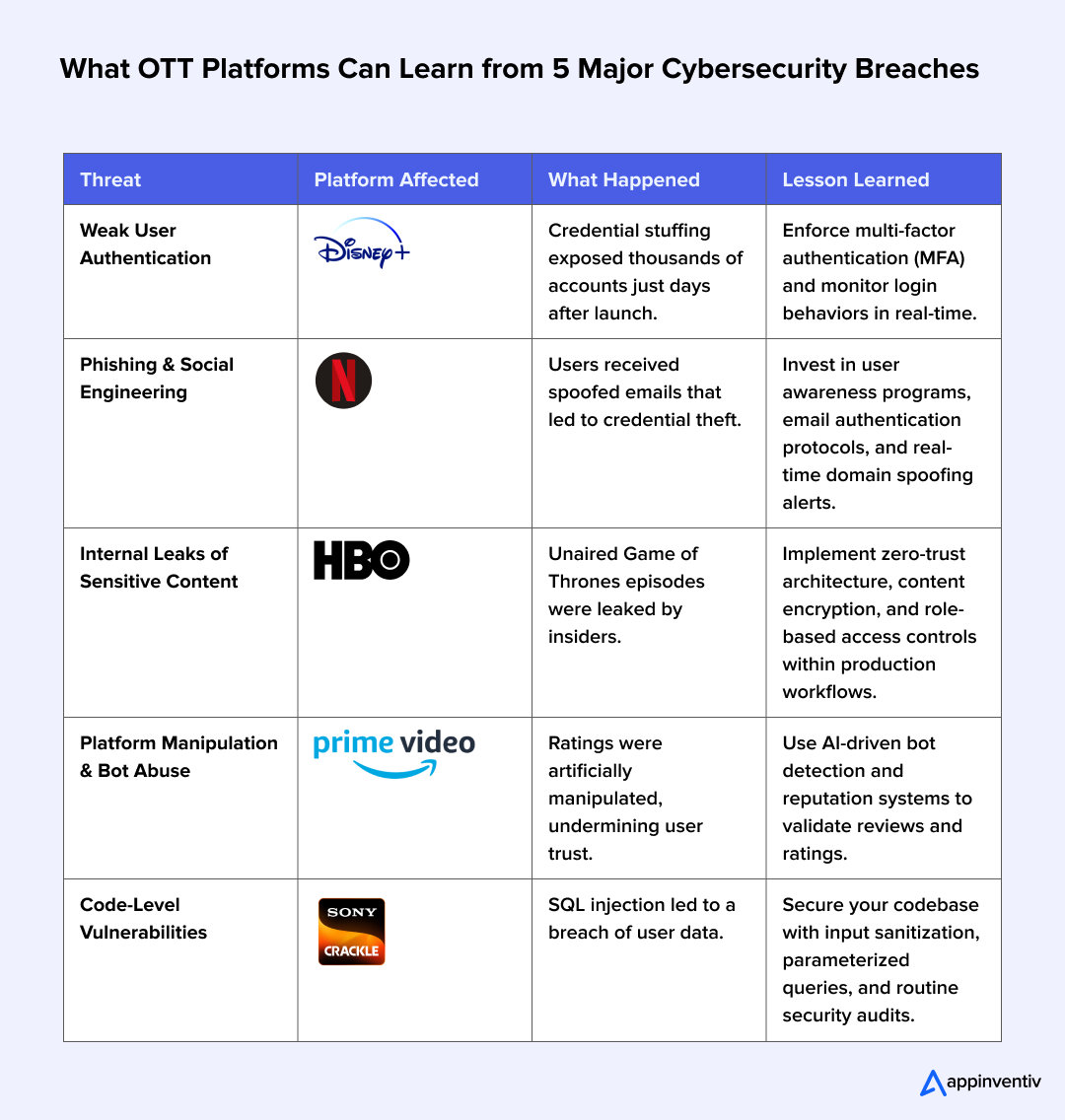
What connects all five OTT content security breaches isn’t just the scale or the platforms involved; it’s the predictability of the threats. Weak authentication, poor internal controls, exploitable code, and manipulated user interactions aren’t new risks. But in high-growth OTT environments, they’re often overlooked in the rush to scale.
The real lesson? Security must evolve as fast as your platform does. Whether you’re launching a new service or managing millions of users, proactive threat modeling, secure-by-design development, and continuous monitoring are no longer optional – they’re non-negotiable.
Use these OTT app security lessons as a blueprint. Learn from the giants. And build your platform on a foundation that the next headline-making breach and secure stream OTT can’t shake.
10 OTT App Security Risks and Their Solutions
Major OTT security issues, like hackers stealing data or breaking into systems, can mess with smooth streaming and put private user details at risk. Here, we’ll break down common OTT app security risks that can cause big disruptions and cost a lot of money. Along with this, we’ll also list the solutions to address them and boost the safety of your platforms.
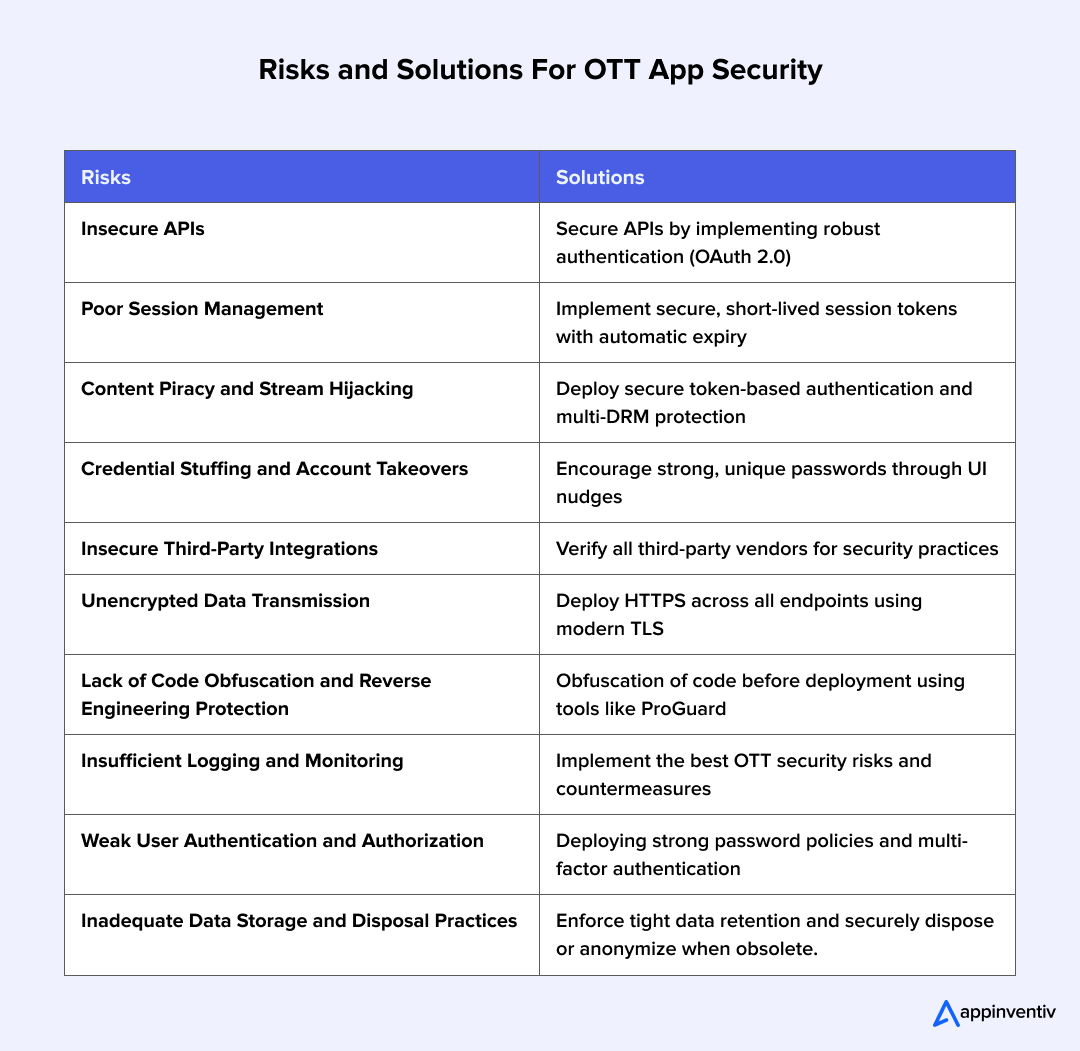
Insecure APIs
APIs power almost every interaction on an OTT platform, from logging in and personalizing content to processing payments and serving recommendations. But if left exposed or poorly configured, it leads to API security risks that create direct pathways for attackers to access user data, hijack accounts, or scrape entire content libraries.
In one notable case, security researchers uncovered that a popular streaming platform’s API allowed unauthorized access to user profiles, including sensitive data like email addresses and viewing history, simply because authentication checks were missing.
While the over-the-top apps security issue was patched before real damage occurred, it exposed how easily flawed endpoints can put millions at risk. The consequences of such movies app security lapses range from data privacy violations and compliance penalties to long-term reputational damage and subscriber loss.
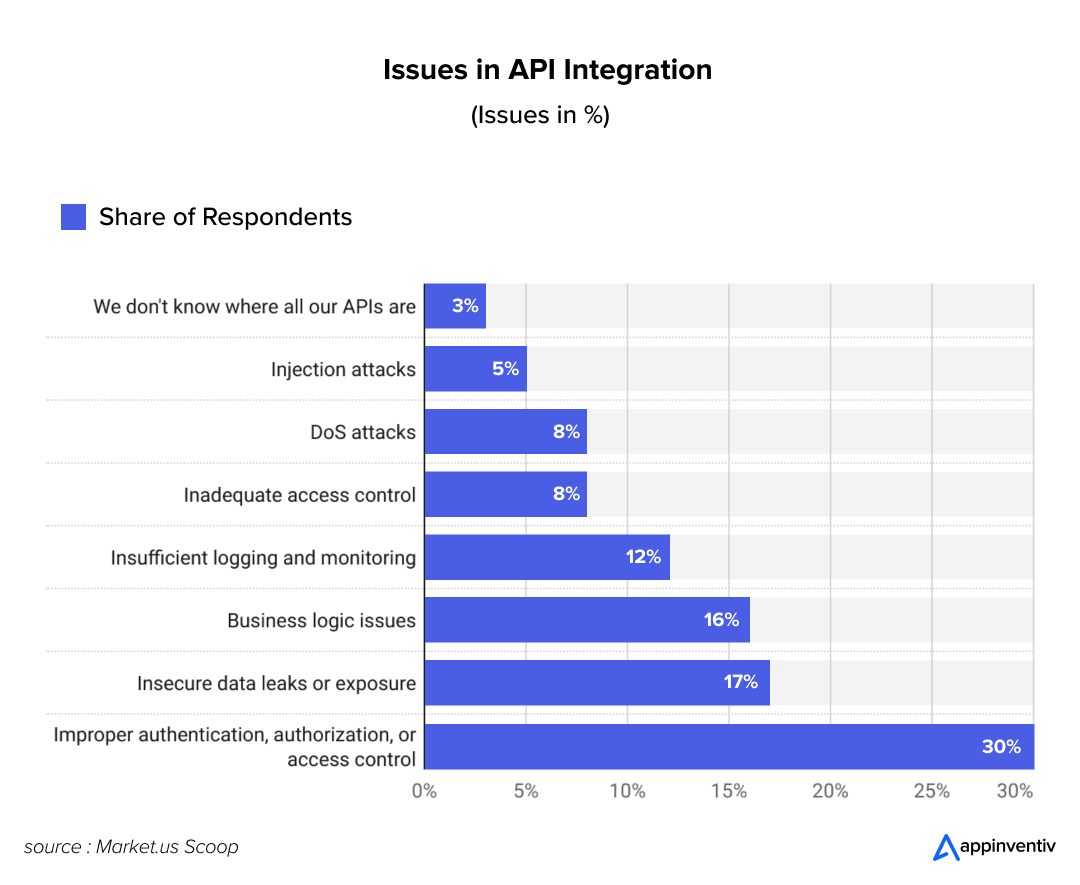
Solution:
Secure APIs by implementing robust authentication (OAuth 2.0), least-privilege access controls, rate limiting, and continuous monitoring via open-source API management platforms and API gateways. Regular security audits and fuzz testing should also be part of a secure stream OTT development lifecycle.
Poor Session Management
Session management is central to delivering seamless user experiences on OTT platforms – but when it’s not handled securely, it opens the door to serious attacks like session hijacking and credential stuffing. Many streaming services allow extended login sessions across multiple devices, which, if not properly protected, can be exploited to gain unauthorized access.
In one case, users of a global OTT app noticed their accounts had been accessed from unknown devices, only to find that the platform didn’t invalidate sessions even after password resets, leaving a vulnerable space open in OTT rights management. That often overlooked OTT app security threats allowed attackers to stay logged in indefinitely, despite users taking corrective action.
The implications of these security risks in custom OTT app development cost are alarming, beyond account compromise, it can erode user trust and increase churn, especially if subscribers feel their data isn’t safe on the platform.
Solution:
Implement secure, short-lived session tokens with automatic expiry, force re-authentication after password changes, and allow users to view and revoke active sessions across devices. Device fingerprinting and financial fraud detection using ML – the best practices for OTT security – can further strengthen session security.
Content Piracy and Stream Hijacking
The security risk in OTT app development is unauthorized access to and redistribution of premium content. Stream hijacking and piracy don’t just chip away at profits; they directly challenge the platform’s ability to monetize its content and protect licensing agreements. OTT content security hack techniques like playback URL sharing, token theft, and exploiting weak DRM implementations are commonly used to illegally stream high-value content and ensure the secure streaming of OTT.
According to ScienceDirect, there were over 215 billion visits to piracy websites in 2022 alone, with OTT content making up a significant portion. In one instance, a global sports broadcaster traced thousands of unauthorized live event streams to a single compromised session that had been streamed widely, costing millions in pay-per-view losses.
The fallout from OTT app security challenges includes revenue loss, regulatory pressure, and damaged relationships with distributors and creators.
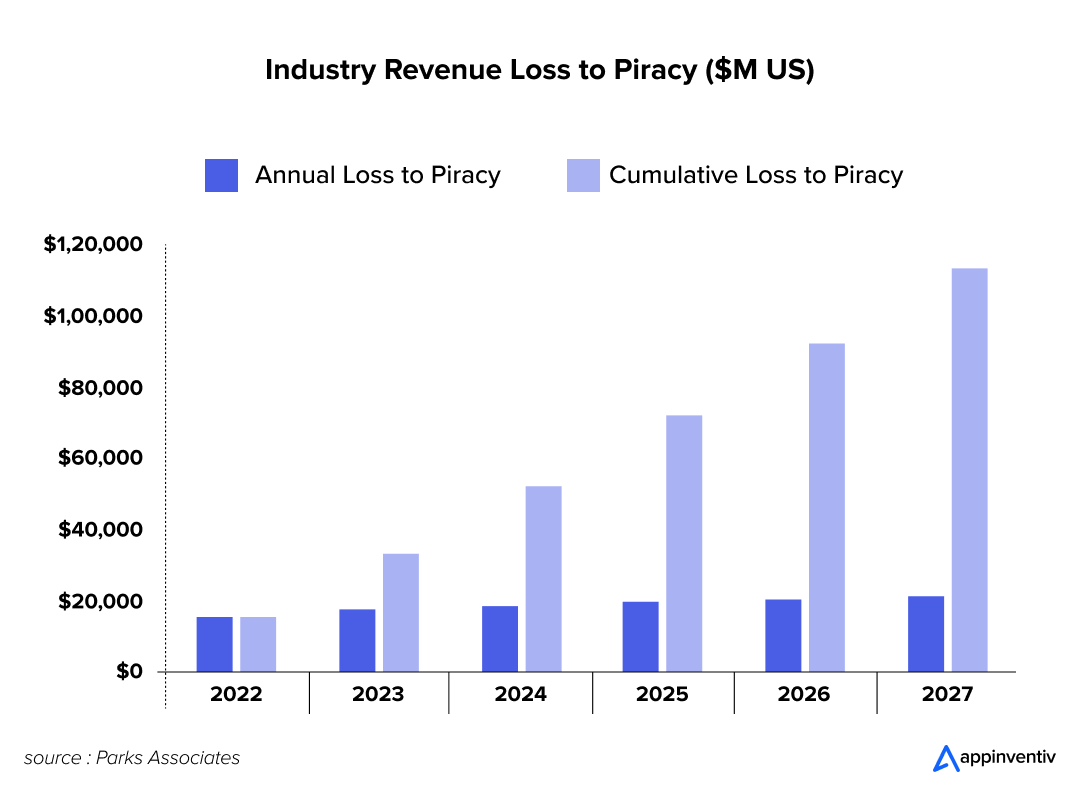
Solution:
Deploy secure, time-limited token-based authentication for streams, implement multi-DRM protection, and consider forensic watermarking to trace leaks. Combine these features of secure OTT app development with real-time monitoring and CDN-level controls to detect and disrupt unauthorized playback.
Credential Stuffing and Account Takeovers
OTT platforms are prime targets for credential stuffing attacks – where leaked usernames and passwords from unrelated breaches are used in bulk to gain unauthorized access. Since many users recycle credentials across platforms, attackers often find success with minimal effort.
In 2023, Netflix users across multiple regions reported unauthorized activity in their accounts, later linked to automated credential stuffing campaigns using botnets. Once inside, attackers not only consume content freely but may also change account credentials, sell access on the dark web, or use the platform as a testing ground for stolen logins.
Bonus Read: Guide to Create a Video Streaming App like Netflix
The OTT app security risks damage isn’t limited to users – platforms face increased customer support costs, fraud risks, and erosion of brand trust.
Solution:
One of the tell-tale benefits of secure OTT app development lies in how well these elements are met – multi-factor authentication, monitor login attempts for abnormal patterns, and integrate bot detection systems. Encourage strong, unique passwords through UI nudges and deny access from known credential breach databases via tools like HaveIBeenPwned.
Insecure Third-Party Integrations
Modern OTT platforms rely heavily on third-party services – analytics SDKs, ad servers, payment gateways, recommendation engines, and more. While these integrations accelerate feature development, they also introduce potential vulnerabilities that are often outside the direct control of your internal security team.
In 2021, a data leak involving a third-party OTT analytics SDK used by several streaming apps led to the exposure of user IP addresses, device data, and session behavior. The issue wasn’t with the platforms themselves, but with how the SDK handled and transmitted data, highlighting the risks of blindly trusting third-party components.
The consequences can be far-reaching: data compliance violations, broken user trust, and compromised app performance.
Solution:
In your OTT security checklist ensure verifying all third-party vendors for security practices, review SDK permissions carefully, and apply a zero-trust approach to integrations. Regular code audits and sandbox testing for external components can help spot red flags before deployment.
Unencrypted Data Transmission
Streaming platforms constantly handle sensitive data—user credentials, payment details, content delivery, and behavioral analytics. When any part of this data is transmitted without proper encryption, several security issues in OTT development emerge: it becomes vulnerable to interception through man-in-the-middle attacks. Even today, some OTT apps either don’t enforce HTTPS consistently or rely on outdated TLS protocols, leaving gaps in their defense.
In one of the prominent OTT security risks examples, researchers at Comparitech found that some regional streaming apps were transmitting data, including login credentials and viewing history – over unencrypted channels, exposing users to eavesdropping on public Wi-Fi networks. Such lapses not only violate data protection laws like the CCPA and GDPR but also invite reputational and legal consequences if exploited.
Solution:
Risk management in OTT app entails enforcing HTTPS across all endpoints using modern TLS versions, disabling legacy protocols, and implementing HSTS headers. Regular vulnerability scans and penetration testing can help identify weak spots in your encryption setup.
Lack of Code Obfuscation and Reverse Engineering Protection
OTT apps, especially on mobile platforms, are frequent targets for reverse engineering. Attackers decompile app binaries to uncover API keys, DRM logic, or proprietary algorithms, and sometimes even inject malicious code into modified versions. These tampered apps are then distributed unofficially, offering ad-free or premium content without authorization.
In a notable case, a popular entertainment app had its Android version cloned and repackaged with adware, eventually infecting thousands of devices via third-party app stores – all because the best practices for OTT security were not in place. The original platform suffered a drop in user trust and spent months cleaning up the reputational damage. Beyond content theft, reverse engineering can expose business logic and open doors to further attacks.
Solution:
Several OTT app security risk management solutions such as obfuscation of code before deployment using tools like ProGuard or DexGuard, especially for mobile clients and integration of runtime protections such as root detection, anti-debugging checks, and certificate pinning to raise the barrier for attackers should be applied.
Insufficient Logging and Monitoring
Without robust logging and monitoring systems, OTT security checklists risk missing critical early warning signs of malicious activities, such as account takeovers, fraudulent behavior, or abuse of platform services. Attacks often begin with subtle anomalies that, if left undetected, can escalate into major breaches.
According to the OWASP API Security Top 10 risk, insufficient logging and monitoring are key vulnerabilities that allow attackers to maintain persistence, pivot to other systems, or tamper with data. Without sufficient detection, platforms may not become aware of security breaches until much later, leading to delayed responses and significant reputational and financial damage.
Additionally, platforms that fail to maintain robust logs may struggle to comply with regulatory reporting requirements after any incident related to security issues in OTT development.
Solution:
Implement the best OTT security risks and countermeasures around centralized logging solutions with real-time alerts for unusual activities, such as unauthorized logins or abnormal API requests. Ensure that logs are immutable and securely stored to facilitate post-incident investigations and meet compliance standards.
Weak User Authentication and Authorization
Weak user authentication and authorization protocols are significant security risks for OTT platforms. Simple, reused passwords, lack of multi-factor authentication, and poor role-based access controls can lead to unauthorized account access, data breaches, and platform abuse.
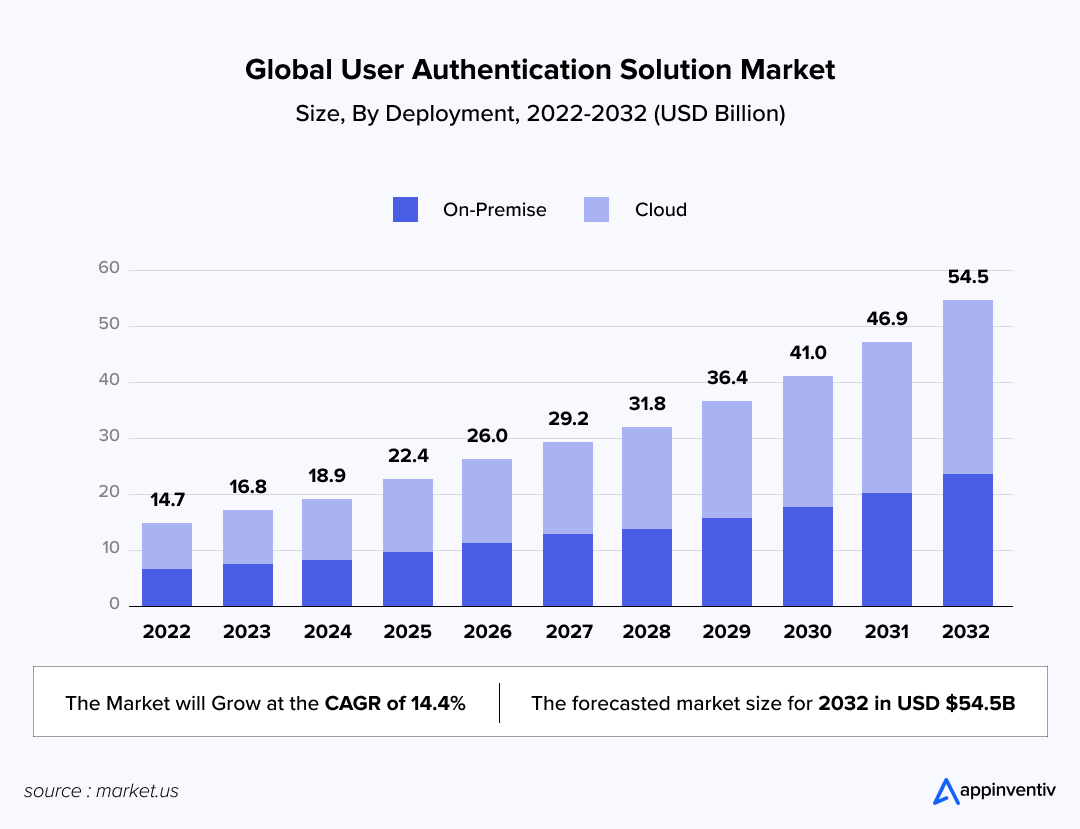
Another prominent OTT security risks examples can be seen in 2019’s incident where Disney+ accounts were compromised through credential stuffing – attackers used leaked username and password combinations from previous breaches to access user accounts. This incident highlighted the vulnerabilities associated with weak authentication practices.
The implications of such breaches are severe – not only in terms of compromised accounts but also potential legal consequences related to data protection laws like GDPR or CCPA, especially if the breach involves personal user information.
Solution:
Some of the best OTT security measures include enforcing strong password policies (e.g., complexity, length), implementing a multi-factor authentication system for all user accounts, and ensuring robust RBAC to restrict access to sensitive content and data. Another mode to ensure risk management in an OTT app would be implementing a regular audit authentication mechanism to ensure they meet industry standards.
Inadequate Data Storage and Disposal Practices
Improper data storage and disposal practices pose a significant security risk for OTT platforms. Sensitive user information, such as personal details, payment history, and viewing preferences – can be exposed if stored insecurely or inadequately disposed of.
A notable example occurred in 2020 with the adult live-streaming platform CAM4, which exposed 10.88 billion records in an unsecured ElasticSearch database. These records included sensitive data like usernames, email addresses, payment logs, and chat transcripts, accessible to anyone who knew the database’s location. While there was no evidence that this data was actively exploited, the exposure highlighted the serious cloud security risks and potential user consequences.
If OTT platforms fail to archive, secure, or dispose of such data properly, they risk significant reputational damage and possible violations of data protection laws like GDPR or CCPA.
Solution:
In your OTT app security solutions, ensure that all sensitive data is encrypted in transit and at rest. Implement strict data retention policies and ensure proper disposal or anonymization of data once it is no longer needed. Regular data storage and disposal system audits can help identify vulnerabilities and ensure compliance with data protection regulations.
How Appinventiv Helps You Build Secure OTT Platforms from Day One
The case studies we just explored clarify one thing: security lapses in OTT platforms aren’t theoretical; they’re happening now, to some of the biggest names in the industry. But these aren’t just cautionary tales. There are opportunities for newer platforms and fast-growing services to build stronger foundations from the start.
As part of our OTT app development services offerings, we work with media brands at every stage, from concept to scale, to ensure their platforms aren’t just engaging and high-performing but also architected with security at the core.
Our OTT app security approach blends streaming technology expertise with a real-world understanding of cybersecurity challenges specific to media platforms. That means fewer vulnerabilities, faster response to emerging threats, and better protection for user data and premium content.
Whether it’s integrating DRM systems to prevent piracy, designing frictionless multi-factor authentication flows, or securing the APIs that power your recommendation engine, we build an over-the-top apps security framework with a forward-looking lens. Compliance, content integrity, platform trust – none of it is an afterthought.
Security isn’t a feature. It’s a standard, and we build it into every OTT solution we deliver.
FAQs.
Q. What are OTT security risks?
A. OTT security risks refer to streaming platforms’ potential threats and vulnerabilities, such as unauthorized access, data breaches, content piracy, and attacks on APIs. Common movies app security risks include credential stuffing, phishing scams, internal data leaks, and exposure of sensitive user information. As OTT platforms often handle a significant volume of user data and premium content, they are attractive targets for cybercriminals looking to exploit any weaknesses.
Q. How to prevent the OTT security risks?
A. To prevent OTT content security risks, it’s essential to adopt a multi-layered security strategy that includes:
- Strong Authentication: Implement multi-factor authentication and strong password policies in your anti-OTT app security threats practice.
- Encryption: Encrypt content and user data both in transit and at rest.
- Access Controls: To limit exposure to sensitive data, use role-based access controls and least-privilege policies in your secure stream OTT.
- Vulnerability Testing: Conduct regular penetration tests and code audits to identify weaknesses.
- Fraud Detection: Integrate AI-based fraud detection systems to monitor and prevent content manipulation, ratings, and user behaviors.
Adopting these best practices to solve security risk in OTT app development and proactive monitoring can significantly reduce the likelihood of security breaches.
Q. What is OTT rights management?
A. OTT rights management refers to the process of managing, licensing, and distributing digital content rights for Over-The-Top (OTT) platforms. This ensures that content is legally streamed or downloaded while protecting intellectual property.
Q. How long does it take to build a secure OTT app?
A. The time it takes to build a secure OTT app depends on the platform’s complexity, the required features, and the level of security integration needed. On average, developing a basic secure OTT app could take 4 to 6 months, while more complex platforms with advanced, best OTT security measures (e.g., DRM, multi-tier authentication, and AI-based fraud detection) may take 6 to 12 months or longer. It’s important to allocate time for thorough testing and security auditing before the app goes live.
Q. What is the cost of developing a secure OTT mobile app?
A. The cost of developing a secure OTT mobile app varies based on factors such as the app’s complexity, security features, and desired platform (iOS, Android, or both). A typical secure OTT mobile app development project can range from $50,000 to $200,000 or more. Factors influencing cost include:
- Custom Features: Advanced features like live streaming, real-time data analytics, and DRM integration.
- Security Features: Multi-layered security protocols, encryption, and fraud prevention tools.
- User Experience: High-quality UX design and platform performance optimization.
It’s important to prioritize OTT app security as part of the overall budget, as vulnerabilities can lead to significant losses in the long run.
Q. How to Overcome OTT Security Challenges?
A. Overcoming OTT security challenges requires strategic planning, the right technology, and ongoing vigilance. Some key steps in building OTT app security solutions can include:
- Adopt a Secure Development Lifecycle: Security must be integrated from the early stages of app development, not as an afterthought.
- Invest in Technology: Leverage technologies such as AI for fraud detection, encryption standards for data protection, and access management solutions to monitor and control access to sensitive content.
- Educate Users: Many security risks stem from human error, so it is essential to educate users on phishing and best security practices.
- Collaborate with Experts: Partnering with a trusted OTT app development company like Appinventiv ensures that your platform is built with security as a priority.
By following these over-the-top apps security practices, you can minimize security risks and build a more resilient, trustworthy OTT service.


- In just 2 mins you will get a response
- Your idea is 100% protected by our Non Disclosure Agreement.

10 Reasons OTT Data Analytics is Critical for Your Business
Key takeaways: OTT analytics are crucial for understanding user behavior and optimizing content strategies. Real-time data enables businesses to make informed decisions promptly. Integrating analytics into OTT platforms can enhance user experience and drive revenue. Appinventiv develops and deploys advanced analytics solutions tailored to your unique business needs. Launching an OTT platform today is easier…

10 Powerful Ways AI is Transforming OTT Streaming Platforms
OTT streaming platforms are revolutionizing how folks watch content, and artificial intelligence in OTT platforms is a driver behind this transformation. Global OTT subscriptions are expected to reach 1.7 billion by 2027; good content is no longer enough in such a crowded space. How smartly that content is tailored and delivered to each viewer counts.…

How Much Does it Cost to Build an OTT App Like Stan?
As our lives become increasingly intertwined with technology, the rise of Over-the-Top (OTT) apps has become an essential facet of modern entertainment. The media consumption landscape is evolving, with digitalization fundamentally altering how we engage with content. Traditional television gives way to a more flexible model where viewers can watch anything, anytime, and on any…










